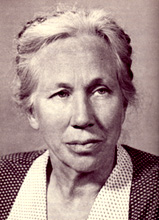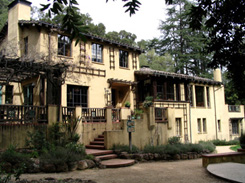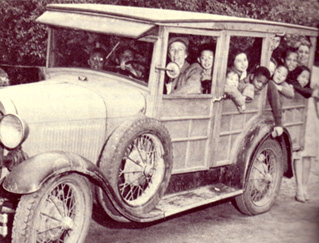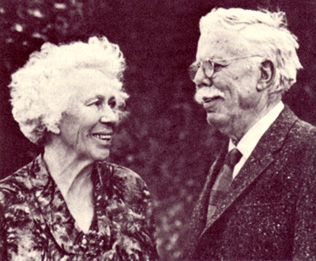 The
Duvenecks' fourth child, son Bernard, was born in late December
1922. The
Duvenecks' fourth child, son Bernard, was born in late December
1922.
Hope, Elizabeth, Francis, and Bernard by the family fireplace
The Duvenecks, like others born into privilege, were determined
to make a contribution to society. Settling into a permanent residence
for the first time since marrying gave Josephine an opportunity
for community involvement.
 The
City of Palo Alto had created a community center, one of the first
such municipal bodies in the United States. Josephine served as
an employment referral counselor, although she had no experience
whatever, with mixed success. Discovering a gift for organization,
she ran for the Palo Alto City Council and was elected to a four-year
term. Frank became active in Democratic Party state and county politics. The
City of Palo Alto had created a community center, one of the first
such municipal bodies in the United States. Josephine served as
an employment referral counselor, although she had no experience
whatever, with mixed success. Discovering a gift for organization,
she ran for the Palo Alto City Council and was elected to a four-year
term. Frank became active in Democratic Party state and county politics.
The Duvenecks had always greatly loved open spaces. In their Model
T Ford they chugged over the Santa Cruz Mountains - quite a hazardous
drive in those days - and camped out in redwood forests, on the
Big Sur coast, and as far as Sequoia National Park, where they experienced
a bear raiding their campsite.
They had dreamed of an open space of their own, and scouted places
to buy on their rambles. In 1924 they were driving home one afternoon
by way of Los Altos, when they saw a sign advertising a thousand
acres for sale. The property was behind a gate above which were
metal flags with the writing "Hidden Villa." A thousand
acres was far bigger than what they had ever considered, but they
opened the gate and drove in. They found the Franciscans' olive
grove, a pasture with cows grazing, bay trees, and at the end of
the road the old white house, barn, and outbuildings. A stream ran
down the hills towards the road. The Duvenecks were completely thrilled
with the place, and contacted the sales agent whose name was on
the gate.
After buying, the Duvenecks continued living in Palo Alto, but spent
weekends and summer at Hidden Villa, and acquired a couple of horses
and a goat. As Palo Alto expanded around their house there they
decided to uproot and move to a new house at Hidden Villa they would
build themselves, living at the old ranch house-stagecoach stop
during construction. The old house was cold, with no electricity
and just a makeshift bathroom on the back porch, but they had the
thrill of watching the new house go up, beginning winter, 1929.
 The design is Spanish-Mediterranean, nestled against a hill on the
opposite creek bank from the older buildings. Just right of the
entryway is a large living room, planned for folk dancing, music
and parties, with a vaulted redwood beam ceiling.
The design is Spanish-Mediterranean, nestled against a hill on the
opposite creek bank from the older buildings. Just right of the
entryway is a large living room, planned for folk dancing, music
and parties, with a vaulted redwood beam ceiling.
The Duveneck House, 2009, photo curtesy of
Josephine insisted on a large picture window, unusual for the time,
over the objection of the architect, who wanted conventional small
lead-pane windows. A local mason built a massive fireplace using
stones the Duvenecks gathered. Left of the entryway is a dining
room, with a kitchen and laundry room beyond.
A cellar had a guest bedroom, and office and storage rooms. Upstairs
were family bedrooms, which looked down on a front garden and the
hillside in back. Compensating for only one bathroom at the old
house, the new house had several. Electric wiring came up Moody
Road. The family moved in just before Thanksgiving, 1930.
 Hidden
Villa, with the new house, was the most significant event in the
Duvenecks' lives, and it took on great significance for the community;
not just locally, but for the whole human community. In her autobiography
Life on Two Levels, Josephine wrote: Hidden
Villa, with the new house, was the most significant event in the
Duvenecks' lives, and it took on great significance for the community;
not just locally, but for the whole human community. In her autobiography
Life on Two Levels, Josephine wrote:
One evening not too long after the move, I was alone sitting
on the stone seat on the hearth by the open fire. As I looked
around the room which was lighted by the flickering light of
the burning logs, it seemed to me that our dream had materialized.
The room was indeed a lovely setting. Yet something was missing;
it was still only a backdrop with no inherent quality - no soul.
I realized that human relationships provide the only real dynamic
in an environment. The subtle essence that we call atmosphere
was still to be created by those living within the four walls
and by the friends or strangers who would pass through. What
happened here would make the difference between just a house
and a home. This thought laid on me a deep responsibility for
the development of the quality that I desired…

Hidden Villa. Camp days
Hidden Villa became a center for social, educational, environmental,
and humanitarian activities. It summer it was a youth camp, to
which the Duvenecks brought minority and disadvantaged children,
and minority counselors, which given the mostly white demographics
of the San Francisco Peninsula, was particularly unusual and innovative.
It had the first youth hostel on the Pacific Slope. World War
II refugees and Japanese-American victims of the World War II
"relocation" - internment - were released to Hidden
Villa. Gatherings included church outings, interracial parties,
and fundraisings. Minority groups were welcome. The hostel accommodated
a Moslem group which met to instruct children in Moslem faith
and rituals. Native Americans met for dancing and feasts.
In the late 1950's Hidden Villa Camp was incorporated as a non-profit.
Hidden Villa charged fees, but they were reasonable, although
the Duvenecks generally paid the taxes, utilities, maintenance,
and capital improvement costs.
 Josephine and Frank Duveneck maintained other interests, chief
among them being the Peninsula School, which opened in 1925 as
a progressive, Montessori-type institution.
Josephine and Frank Duveneck maintained other interests, chief
among them being the Peninsula School, which opened in 1925 as
a progressive, Montessori-type institution.
The Duveneck children went there (they had no choice), but were
treated like other pupils. Josephine was school director for 16
years, and Frank taught mathematics, shop, and served on the board.
Hidden Villa, however, remains the Duvenecks' greatest legacy,
embodying their generous, humanitarian spirit.
Back to Resources Page
|
About
LAHHS
Events
Timeline
Resources
Membership
Contact
Us
Home
|
